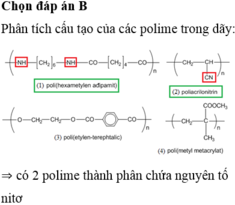Cho các polime sau: (1) poli (metyl metacrylat); (2) polistiren; (3) nilon‒7; (4) poli (etylenterephtalat); (5) nilon‒6,6; (6) poli (vinyl axetat). Các polime được điều chế bằng phản ứng trùng ngưng là

Những câu hỏi liên quan
Cho các polime sau: polietilen, nilon-6,6, poliacrylonitrin, poli(etilen-terephtalat), poli(metyl metacrylat). Số polime trùng ngưng là
A. 4.
B. 3.
C. 2.
D. 5.
Đáp án C
Polime trùng ngưng là nilon-6,6, poli(etilen-terephtalat).
Đúng 0
Bình luận (0)
Cho các polime sau: (1) Poli(phenol fomanđehit), (2) Polietilen, (3) Polibutađien, (4) Poli(acrilonitrin), (5) Poli(vinyl clorua), (6) Poli(metyl metacrylat). Những polime được dùng làm chất dẻo là A. 1,2,3,4,6 B. 1,2,3,4,5 C. 1,2,5,6 D. 1,2,3,5
Đọc tiếp
Cho các polime sau: (1) Poli(phenol fomanđehit), (2) Polietilen, (3) Polibutađien, (4)
Poli(acrilonitrin), (5) Poli(vinyl clorua), (6) Poli(metyl metacrylat). Những polime được dùng làm chất
dẻo là
A. 1,2,3,4,6
B. 1,2,3,4,5
C. 1,2,5,6
D. 1,2,3,5
Cho các polime sau: cao su buna, tơ xenlulozơ axetat, poli(vinyl clorua), poli(metyl metacrylat), amilopectin, poli(etylen terephtalat). Số polime tổng hợp là
A. 2
B. 3
C. 4
D. 5
Chọn C.
Polime tổng hợp là cao su buna, poli(vinyl clorua), poli(metyl metacrylat), poli(etylen terephtalat)
Đúng 0
Bình luận (0)
Cho các polime sau: cao su buna, tơ xenlulozơ axetat, poli(vinyl clorua), poli(metyl metacrylat), amilopectin, poli(etylen terephtalat). Số polime tổng hợp là
A. 2.
B. 3.
C. 4.
D. 5.
Chọn C.
Polime tổng hợp là cao su buna, poli(vinyl clorua), poli(metyl metacrylat), poli(etylen terephtalat)
Đúng 0
Bình luận (0)
Cho dãy các polime sau: (1) poli(metyl metacrylat), (2) poliacrilonitrin, (3) nilon-6,6, (4) poli(etylen terephtalat). Các polime là sản phẩm của phản ứng trùng hợp là
A. (1) và (4).
B. (2) và (3).
C. (1) và (2).
D. (3) và (4).
Chọn đáp án C
Các polime (1): thủy tinh hữu cơ và (2): tơ nitron.
Đúng 0
Bình luận (0)
Cho dãy gồm các polime sau: (1) poli(hexametylen ađipamit), (2) poliacrilonitrin, (3) poli(etylen terephtalat), poli(metyl metacrylat). Số polime có thành phần hóa học chứa nguyên tố nitơ là
A. 1.
B. 2.
C. 3.
D. 4.
Cho các polime sau: (1) poli(metyl metacrylat); (2) polistiren; (3) nilon -7; (4) poli(etylenterephtalat); (5) nilon -6,6; (6) poli(vinyl axetat). Các polime được điều chế bằng phản ứng trùng ngưng là A. (1), (3), (6) B. (3), (5) C. (1), (3), (5) D. (3), (4), (5)
Đọc tiếp
Cho các polime sau: (1) poli(metyl metacrylat); (2) polistiren; (3) nilon -7; (4) poli(etylenterephtalat); (5) nilon -6,6; (6) poli(vinyl axetat). Các polime được điều chế bằng phản ứng trùng ngưng là
A. (1), (3), (6)
B. (3), (5)
C. (1), (3), (5)
D. (3), (4), (5)
Cho các polime sau: poli(etylen terephtalat), poliacrilonnitrin, polistiren, poli(metyl metacrylat). Số polime được điều chế bằng phản ứng trùng hợp là
A. 2
B. 3
C. 4
D. 1
Chọn B
Có 3 polime được điều chế bằng phản ứng trừng hợp là poliacrilonnitrin, polistiren, poli(metyl metacrylat) còn poli(etylen terephtalat) thì điều chế bằng phản ứng trung ngưng.
Đúng 0
Bình luận (0)
Cho các polime: (1) poli(phenol-fomanđehit), (2) poli(vinyl axetat), (3) poli(metyl metacrylat), (4) poli(etylen terephtalat). Polime không thuộc loại polieste là
A. (4).
B. (1).
C. (3).
D. (2).



